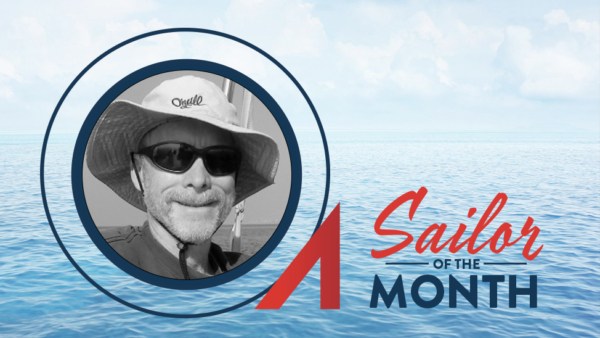 Continuing the “Voyaging with Velella” series by ASA writer-at-large Meghan Cleary. Meghan, Prescott and their kitten Nessie are on a planned 9-month cruise in the tropics.
Continuing the “Voyaging with Velella” series by ASA writer-at-large Meghan Cleary. Meghan, Prescott and their kitten Nessie are on a planned 9-month cruise in the tropics.
We’ve been living at anchor in La Cruz de Huanacaxtle, hanging out between visits to beautiful Banderas Bay. The water is flat here and the winds are consistently great for sailing, kind of like the Mexican equivalent of San Francisco, minus the fog. Despite the good sailing here, anchoring options are scant, with La Cruz being the only place that’s really protected from prevailing winds and swell, both in Banderas Bay and 30 miles on either side of the entrance. Luckily, La Cruz has an enormous anchorage, and as I write this, we are one of perhaps 55 boats seeking shelter from a howling norther coming out of the Sea of Cortez.
Northers are a common weather pattern in the Sea in the winter, and the strong ones can affect us even way down here. Southern Californians will can commiserate; the Santa Anas that howl over the Pacific there from an easterly direction are a result of the same high pressure system that produces northers in the Sea of Cortez. The Sea also has the nice feature of basically being a 600-mile wind tunnel. So we’ve got that going down here.
By noon, the clouds marched in and piled up and it feels just like home in the Pacific Northwest. The wind is screaming down our dorade vents and we put hot chocolate on the stove. We thought about lighting the propane furnace (but then decided that we’ve gone soft and refused to be that wimpy. We put pants on instead). All 55 boats here are hard-back on their anchors, and you can see people out on their decks checking for snubber chafe frequently. We snapped the sail covers closed so they wouldn’t flap, and turned on the GPS anchor alarm to alert us right away if we pulled the hook. No sooner had we done that than we hear on the radio “La Cruz anchorage: There’s a boat on the run.”
We turned up the handset and recognized our friend Will’s voice responding “Can you describe where the boat is that’s dragging and I’ll come help you get a hold of it?”

“It’s the Melinda, the pretty little schooner, she’s on the run and headed past the green boat in the middle of the anchorage.”
At first she was difficult to spot from our vantage point, because she was headed almost straight for us. When people started to realize which boat it was, several dinghys zipped over to help. The first tactic when dragging anchor–whether in your boat or on someone else’s–is to let out more scope on the chain, which is exactly what they did. Letting out more scope changes the ratio of water depth to horizontal pull on the anchor (and the more horizontal pull, the better chance the anchor has of digging in). But it was soon clear that letting out more scope would not stop this boat from dragging because she had already gained too much speed. And she was dragging her hook right across a row of boats, threatening to pull out their anchors too.

She was headed fast towards a neighboring boat who we happened to know was engineless. If Melinda pulled our neighbor’s hook out, he’d have to raise sail and maneuver out of that forest of boats fast–and in high winds. So Prescott rowed our dinghy over to our neighbor’s boat to lend a hand on deck. We decided I should stay onboard Velella because we were also in the wayward boat’s path–I wanted to be able to fend her off if need be.
Meanwhile, the people rescuing Melinda were having a hard time because the owner had not left the keys in the ignition when he left the boat. While it’s counterintuitive to leave the keys in the ignition when you go ashore, it’s a good idea for this very reason. The community of cruisers is a tight one, and people are always looking out for each other’s boats when people go ashore. It’s a good idea to leave your keys in the ignition in the event that someone has to jump on your boat and help you out!
As it was, there was no way to turn on the engine of the dragging schooner. With a small fleet of four dinghys acting as tugs alongside, and a guy at the tiller of the schooner steering her, they were able to push the bow this way and that as she drifted through the anchorage, keeping her clear of all other boats. When they reached a large clear spot, they dropped the hook again and let out plenty of scope, letting the strong wind help set her back on the hook.

The captain of the wayward boat came back just as they were getting the hook set again. To his credit, he got on the radio and gave a gracious apology and thank you to everyone who had helped. The responses were “Well said,” and “Don’t worry about it, it happens to everybody,” and “We’re all here to take care of each other,” along with a series of microphone clicks on the VHF (a sailor’s substitute for a round of applause).
Morals of the story: 1. It’s always, always better to have too much scope than too little when anchoring. 2. Leave your keys in the ignition when you go ashore so other cruisers can more easily help you out if there are problems while you’re gone! 3. Most importantly, being gracious about your mistakes is an excellent way to make friends, both in sailing and in life.
Here’s where Velella is dropping anchor tonight.
View Voyaging with Velella in a larger map












